|
Jenn Manak and Debra Wellman The beauty of language is illuminated through stories in rhyme and novels in verse. The rhyming picture books in this column include repetitive phrases and corresponding illustrations making them particularly good for beginning readers. The novels in verse, from stories of adventure and survival to coming of age and love, introduce readers to well-developed characters including strong female protagonists. The authors’ rich word choices and vivid descriptions carry the reader rhythmically through these novels in verse. 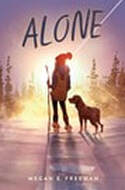 Alone. Megan E. Freeman. (2021). Aladdin. Twelve-year-old Maddie wakes up all alone to a desolate town that was evacuated overnight due to an “imminent threat.” Her divorced parents, each thinking Maddie is with the other, do not realize she is all alone and has no way to contact them. Maddie learns to survive without power, running water, and phone access. She and her Rottweiler, George, endure natural disasters, looters, and wild animals, but Maddie continues to question if she can endure the intense loneliness with only the company of George and her favorite authors. In a series of linked titled poems, Megan Freeman vividly portrays Maddie’s perseverance and ingenuity in the face of danger and isolation. (Gr 6-8) —JM 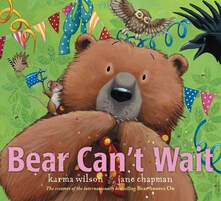 Bear Can’t Wait (Bear Books #8). Karma Wilson. Illus. by Jane Chapman. (2021). Margaret K. McElderry. Bear and his friends are planning a surprise birthday for their friend, Hare, but Bear is so impatient for the party to start. Bear can’t wait! With just two hours to the party, Bear rushes to help, making a mess and almost ruining the surprise. “Time is almost up, / but Bear is very fast. / They bake a new cake / even better than the last.” With the help of his friends, the party is ready just in time for Hare’s arrival. The frolicking text and detailed acrylic illustrations guide the reader to eagerly wonder what Bear and friends are going to do next. Young readers will delight in seeing how the friends all work together to clean up Bear’s mess and throw a wonderful birthday party. (PreK-Gr 2). —JM  The Deepest Breath. Meg Grehan. (2019). Houghton Mifflin Harcourt. Eleven-year-old Stevie loves to read and keeps a list of the things that she wants to learn about. Stevie finds that the more she knows about things, the more she feels safe and in control. But there is one question that she needs to know the answer to the most: What is the fizzy feeling she has in her chest when she sees her friend Chloe? Meg Grehan addresses issues of identity, sexuality, and anxiety in this engaging novel in lyrical verse for middle schoolers. (Gr 3 Up) —JM 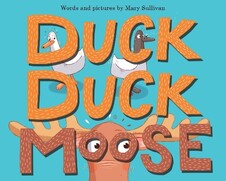 Duck, Duck, Moose. Mary Sullivan. (2021). Houghton Mifflin Harcourt. Duck, Duck, Moose plays off a beloved children’s game as the characters search for missing Goose. Through repetition of sight words and rhymes, the playful text follows the characters as they search the farm for Goose all day. After a misadventure with a beehive, Duck, Duck, and Moose give up and head for home. Even though they miss Goose, they settle down for bed. The next morning Goose appears. Where has she been? (PreK-Gr 2) Mary Sullivan’s digitally created illustrations add to the liveliness of the text. (PreK-Gr 2) —DW 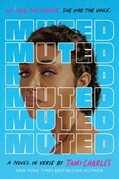 Muted. Tami Charles. (2021). Scholastic. Muted is a dark trip inside the abusive music business where women (and young girls) are expected to give of themselves in order to succeed. Denver and her two high school friends get the attention of a music icon who promises to propel them to great heights. Though they are talented, they are quickly pitted against one another and cut off from talking to family and friends. When Denver uncovers the truth, she is determined to bring this icon and abuser down. “But there in that moment / I KNEW exactly who I was / a fearless / gifted / brilliant . . .” The intensity of this novel in verse builds chronologically, sometimes with several entries in a single day, as the girls shoot for their dreams of stardom. Using her own experience along with those of other artists, Tami Charles does not water down the vivid, harsh experiences of sexual predation, drug use, rape, and abuse. (Gr 9-12) —DW  The One Thing You’d Save. Linda Sue Park. Illus. by Robert Sae-Heng. (2021). Clarion. Linda Sue Park’s novel in verse written in sijo, a traditional Koran poetry form, begins with Ms. Chang asking her classroom of middle schoolers, “If your home is on fire, what is one thing that you would save?” The voices within the diverse classroom are captured as the students share what they would save and why. While some would take a sentimental sweater, photo, or autographed game ball, others would choose to take sneakers or a laptop. The diversity of the students’ responses to this thought-provoking question can lead to a rich discussion of items and compelling reasons for saving them. (Gr 3 Up) —JM  The Power of Yet. Maryann Cocca-Leffler. (2021). Abrams Appleseed. Little Pig is eager to grow up and do all the things that Big Pigs can do—ride a bike, play a violin, and ride a big roller coaster. The relatable pen-and-ink and watercolor illustrations accompanying Maryann Cocca-Leffler’s rhyming text with the repeated refrain “Not Yet!” emphasizes the power of the growth mindset. With patience, persistence, and practice, Little Pig learns that over time he can reach his dreams and goals. “You’ll get sad and angry, / but don’t you quit— / you have power and courage, / and that’s called GRIT.” Little Pig continues to practice and learn from his mistakes and realizes the power of yet! (PreK-Gr 2) —JM 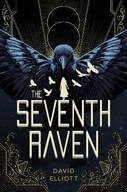 The Seventh Raven. David Elliott. Illus. by Rovina Cai. (2021). Houghton Mifflin Harcourt. David Elliott’s novel is a loosely based retelling of Grimm’s (1819) fairy tale “Seven Ravens,” in which a husband and wife wish for a daughter, but seven sons are born. When the eighth child is born, their wish has been granted, but their daughter is deathly ill. The father sends their sons for water so the priest can baptize Jane before she dies. When they fail to return, he angrily cries, “These boys are a torment / No better than ravens / Eaters of carrion / Scourge of the sky.” As he utters these words, the curse becomes reality. “And seven new birds / Appear overhead / Not there before / And the boys are no more.” The cadence of the verses is captivating. The different forms of poetry Eliot uses for each of the characters are explained in the back matter. While many themes could be assigned to individual chapters, the idea of unintended consequences is one that resonates in this novel. Particularly effective is the idea of one not feeling right in one’s skin as the seventh son, picked on as a boy, loves the freedom of being a raven. (Gr 6 Up) —DW 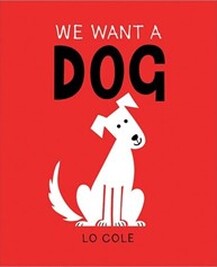 We Want a Dog. Lo Cole. (2021). Sourcebooks Jabberwocky. Lo Cole uses only red, black, gray, and white to create bold, inviting images of various dog breeds for this story which opens with “We want a dog. What kind of dog?” The reader views a variety of “types” of dogs. “Ones that begs? / One the sheds? / One that rips things into shreds?” Instead of focusing on the merits of different breeds, Cole points out characteristics of all dogs including the not-so-great ones like shedding, eating out of the garbage, and getting fleas. With its clever rhyming story which ends with a surprise twist, We Want a Dog is a great read-aloud choice. Parents will also appreciate the opportunity this book provides for a discussion about the responsibilities of pet ownership. (PreK-Gr 2) —DW 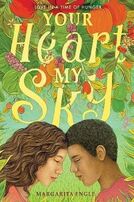 Your Heart, My Sky: Love in the time of Hunger. Margarita Engle. (2021). Atheneum. Margarita Engle’s novel in verse presents a poignant story of love and survival set in a period of Cuban history that many are unaware of—a time of near starvation for most of the island inhabitants during the 1990s. The U.S. Embargo on Cuba played a crucial role in this devastating period in Cuban history that Cubans referred to as “el período especial en tiempos de paz,” which translates to “the special period in times of peace.” Liana and Amado are teenagers who independently choose to defy the government requirement for them to “volunteer” as farm laborers, a choice that could land them in jail. A stray dog brings the two together as they find ways to survive during a difficult time. (Gr 9-12) —DW Jennifer Manak is an Associate Professor of Education at Rollins College in Winter Park, Florida. Deb Wellman is a Professor Emeritus of Education at Rollins College in Winter Park, Florida.
0 Comments
Leave a Reply. |
AuthorsThese reviews are submitted by members of the International Literacy Association's Children's Literature and Reading Special Interest Group (CL/R SIG). Archives
May 2024
Categories
|

 RSS Feed
RSS Feed